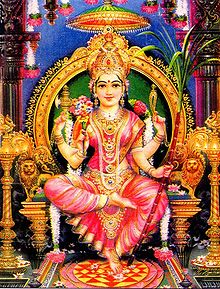| Tripura Sundari | |
|---|---|
Mother Goddess; One of the Highest Forms of Mahadevi The Governess of the Universe Supreme Being (Srikula-Shaktism) | |
| Member of The Ten Mahavidyas | |
 Painting of the Goddess, Tripura Sundari | |
| Other names | Kamakshi, Kameshvari, Lalita, Lalitambika, Rajarajeshvari, Shodashi, Sri Mata, Uma, Parvati, Maha Bhairavi, Shambhavi, Adishakti, Durga, Neelotpalambika, Brihadambika, Girija |
| Abode | Manidvipa / Śrī Nagara |
| Mantra |
|
| Weapon | Pasha (noose), Ankusha (elephant goad), arrow and sugarcane bow[1] |
| Symbols | Sri Yantra |
| Day | Friday |
| Mount | Lion |
| Texts | |
| Gender | Female |
| Region | Worshipped In the form of Goddess Kamakshi and Kamakhya in Kanchipuram and Assam |
| Festivals |
|
| Consort | Kameshvara, a form of Shiva |
Tripura Sundari (Sanskrit: त्रिपुरसुन्दरी, IAST: Tripura Sundarī), also known as Rajarajeshvari, Shodashi, Kamakshi, and Lalita, is a Hindu goddess, revered primarily within the Shaktism tradition and recognized as one of the ten Mahavidyas.[2] She embodies the essence of the supreme goddess Mahadevi. Central to the Shakta texts, she is widely praised in the Lalita Sahasranama and Saundarya Lahari.[3] In the Lalitopakhyana of the Brahmanda Purana, she is referred to as Adi Parashakti.
The term "Tripura" conveys the concept of three cities or worlds, while "Sundari" translates to "beautiful woman." She signifies the most beautiful woman across the three realms, with associations to the yoni symbol and the powers of creation, preservation, and destruction.
According to the Srikula tradition in Shaktism, Tripura Sundari is the foremost of the Mahavidyas, the supreme divinity of Hinduism and also the primary goddess of Sri Vidya. The Tripura Upanishad places her as the ultimate Shakti (energy, power) of the universe.[4] She is described as the supreme consciousness, ruling from above Brahma, Vishnu, and Shiva.[5]
The Lalita Sahasranama narrates the cosmic battle between Lalita Tripura Sundari and the demon Bhandasura, symbolizing the triumph of good over evil. This sacred text offers a detailed portrayal of her divine attributes and qualities. Temples dedicated to her exist across India, with prominent ones in Tripura, West Bengal, Tamil Nadu, Andhra Pradesh, Telangana, Jharkhand, and Karnataka. Her festivals, including Lalita Jayanti and Lalita Panchami, are celebrated fervently, reflecting devotees' deep spiritual connection to the goddess and her embodiment of the divine feminine energy.
- ^ Kinsley 1998, p. 112.
- ^ Kinsley 1998.
- ^ Das 2001.
- ^ Mahadevan 1975, pp. 235.
- ^ Brooks 1990, pp. 155–156.